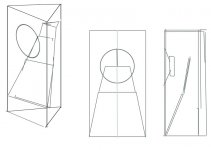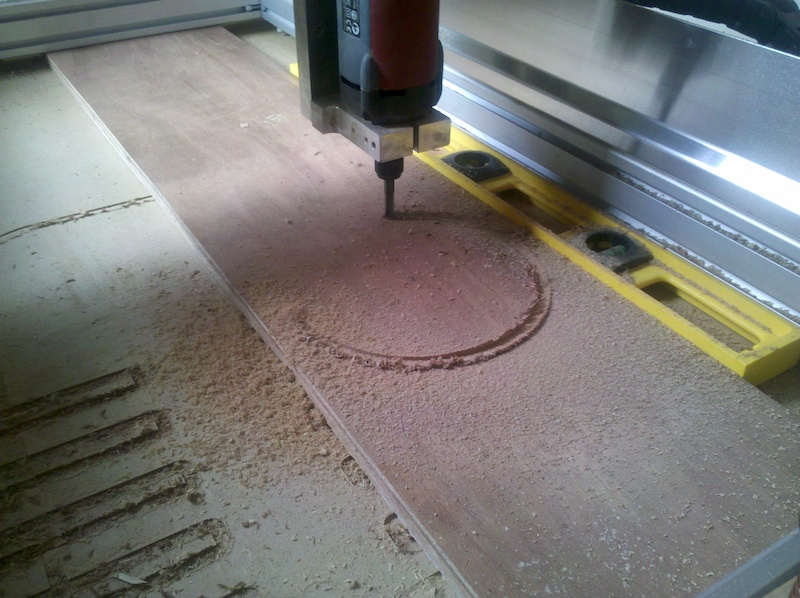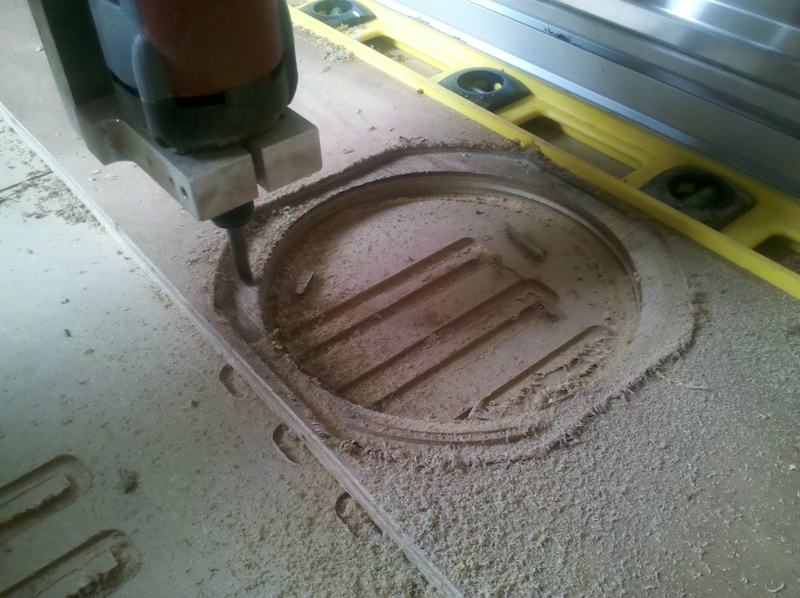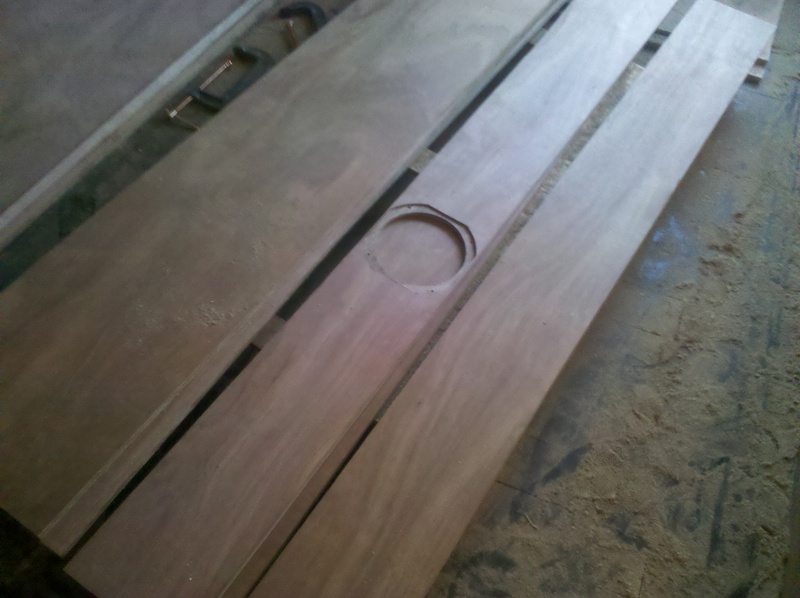Remember to chamfer well around the edges if you are using a thick baffle. And remember to do it it in a fourleaf (or however many screws are used for this driver) clover pattern so the screws have enough material to bite into. Use a rasp and round file for this as it is virtually impossible to do well enough with a handheld router. If you have access to CNC equipment that's a different story though.
Thanks Squeak, I will use the clover pattern, I have a cnc mill so will be able to open the back out with a nice chamfered profile.
You might try using a very thin plywood or even foam core inner divider panel and curve it in an arc to make more room for the driver. This was done with some success in the Flat BIB or FIB. The slight curve changes the horn from conical-conical to parabolic-hyperbolic by a slight amount. It does not alter the character of the BIB too much and provides a lot more flexibility to mounting larger drivers. Plywood can be curved by cutting partial depth slots on the concave side. Bendy plywood that has this treatment already is also available but for the slight arc you need to clear the magnet you can do it with some slots.
I actually wondered if that was an option. The ply I have would be difficult to bent and hold in place easily unless I machined a profile for it to sit into on the inner face of the side panels, foam sounds like a good call. Is there a particular type of foam I should look out for?
I will provide my work of geniusonly if Cool Hand wants to build it !
But I doubt it, since he said that it was too difficult to make the ...ehm...60° edges on the panel- indeed they are 30° each
haha yeah, I just want to go for something simple for my first attempt. I wouldnt even try to mitre the edges by hand and my mill probably isnt big enough for a panel of that size. You should post what you have in mind though..
Last edited:
Theres even less room to manoeuvre if I mount it sideways, not to worry, ill just increase the baffle thickness.
I was going to suggest a supra-baffle as thick baffles are mostly a waste of materials, unnecessary extra weight in a cab like the BIB and in other cabs, bracing does more good overall per added pound.
Regardless, looking forward to how it performs since I don't recall anyone trying this brand in a BIB yet.
GM
I was going to suggest a supra-baffle as thick baffles are mostly a waste of materials, unnecessary extra weight in a cab like the BIB and in other cabs, bracing does more good overall per added pound.
Regardless, looking forward to how it performs since I don't recall anyone trying this brand in a BIB yet.
GM
If I can bend the inner panel then I will probably opt for a thinner baffle, with the recess milled into the front panel, something like the picture attached which I snagged from the big BIB thread. That to me is an absolute work of art! the perfect looking speaker?
An externally hosted image should be here but it was not working when we last tested it.
I hadnt given bracing much thought, but i may have to now as if I use a foam inner panel then thats going to lead to decreased stiffness. The panels will all be bonded together with epoxy.
Im pretty excited to see how it turns out as well, and ill make sure to post lots of pics of the build.
It worked better in my mind
But this is it! It's BR not BLHNor BIB !!!
Interesting! I take it the port opens at the bottom of the speaker? has anyone tried anything like this before?
It's BR
Hmm, it's what I call a big vent reflex [BVR], which is what virtually all so-called BLHs are.
GM
That to me is an absolute work of art! the perfect looking speaker?
I hadnt given bracing much thought, but i may have to now as if I use a foam inner panel then thats going to lead to decreased stiffness.
Yes, well proportioned columns have historically been considered works of art.
Yes, divider boards in horns are prone to flexing, so out of foam, flex wood or similar I imagine it will need significant bracing.
GM
Seriously? Virtually impossible w/ handheld router?
Lot of people will be surprised to hear they routinely do the "impossible".
Lot of people will be surprised to hear they routinely do the "impossible".
Remember to chamfer well around the edges if you are using a thick baffle. And remember to do it it in a fourleaf (or however many screws are used for this driver) clover pattern so the screws have enough material to bite into. Use a rasp and round file for this as it is virtually impossible to do well enough with a handheld router. If you have access to CNC equipment that's a different story though.
Next to draw and mill out the baffle, then bond it all together with epoxy. As you can see my living room (pic 3) has a WAF of -23 
Im also considering bleaching the plywood to get that nice dull grey effect. The reddish colour on the top ply doesnt suit me somehow and I dont want to just paint it and lose the grain of the wood.
Im also considering bleaching the plywood to get that nice dull grey effect. The reddish colour on the top ply doesnt suit me somehow and I dont want to just paint it and lose the grain of the wood.
Seriously? Virtually impossible w/ handheld router?
Lot of people will be surprised to hear they routinely do the "impossible".
Well if you want an angle much below 45, I haven't seen any router bits to do it.
And how you'll do the routing guide I'd also be interested in seeing.
Well if you want an angle much below 45, I haven't seen any router bits to do it.
And how you'll do the routing guide I'd also be interested in seeing.
why would you want an angle below 45? but if you did, CMT among others makes chamfer bits (top bearing) at 11.25, 15, 22.5 and 30deg
I've machined scores of baffles by hand using a cheap Makita laminate trim router with a clear plastic base plate.
If you mark out the "pads" around which you want to scallop the chamfer and take your time, it's a pretty simple procedure - sure you'll get a little burning, but that side is hidden after all . A full size router with a larger opening of visibility would make it even simpler.
All the P10 FH3 flat pak kits for Alpair drivers were done that way
- Status
- This old topic is closed. If you want to reopen this topic, contact a moderator using the "Report Post" button.
- Home
- Loudspeakers
- Full Range
- Advice on enclosure



